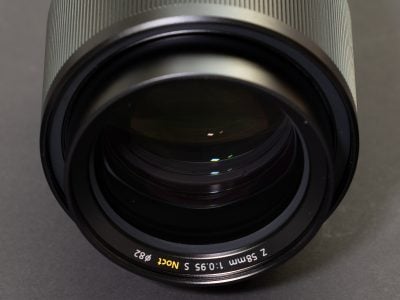Nikon Z 58mm f0.95 Noct review
-
-
Written by Thomas
Quality
Testing: Longitudinal Chromatic Aberration and focus shift
Lenses with focal ratios of f2.8 or larger are often prone to longitudinal color aberrations (loCA, a.k.a. “axial color” or “bokeh CA”). These show up as magenta coloration in the foreground and greenish hues in the background and are not easily corrected in post-processing. The loCA of the new Z Noct Nikkor is a little stronger than from the very good Zeiss Otus and Nikon Z 50mm f1.8 S:
Nikon Z 58mm f0.95 S Noct Longitudinal Chromatic Aberration (loCA)
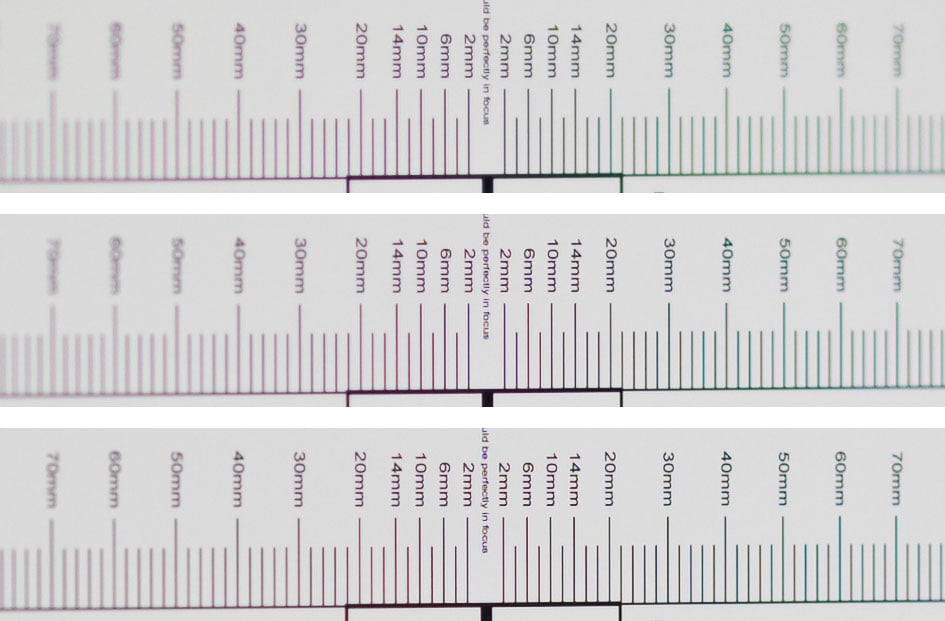
100% crops, from top to bottom: f0.95, f1.4, f2.0; left = foreground, right = background
The test also revealed that there is no focus shift to speak of at distances of 2m and farther away although the background sharpens up faster than the foreground when the lens is stopped down. For comparison have a look at the Mitakon 50mm f0.95 III, Nikon 58mm f1.4G, Zeiss Otus 55mm f1.4 (both shown at f1.4/f2.0/f2.8), and the Nikon Z 50mm f1.8 S shown at f1.8/f2.0/f2.8.
The following real life shot shows that the Z Noct produces some purple fringing around high-contrast edges in the focal plane and green outlining around background subjects:

Above: Nikon Z 58mm f0.95 S Noct at f0.95; 100% crop; click image to access 4k version
But this is not a pronounced issue as you can see in the shot of the painted glass window on the samples page: although the glass is not completely in focus and the background is very bright daylight there is no loCA or purple fringing to speak of.
Sharpness and contrast
Let’s have a look at the theoretical performance of the new Nikon Z 58mm f0.95 S Noct and compare it to the performance of the Leica Noctilux-M 50/0.95 ASPH, Nikon 58mm f1.4G, and Zeiss Otus 55mm f1.4:
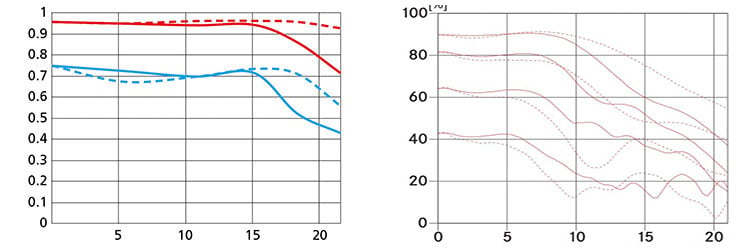
Above: MTF Nikon Z 58mm f0.95 S Noct (left), Leica 50mm f0.95 Noctilux (right) at f0.95
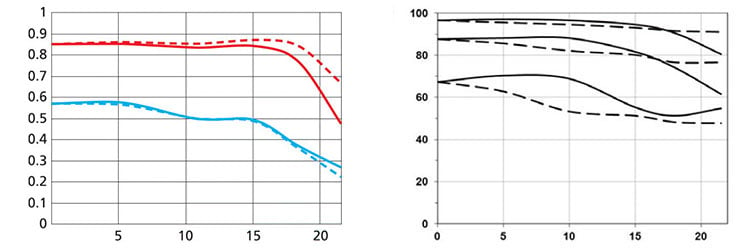
Above: MTF Nikon 58mm f1.4G (left), Zeiss Otus 55mm f1.4 (right) at f1.4
These MTF charts of the Nikon lenses show the computed lens-performance wide open without influence of diffraction at 10 line-pairs/mm (in red) and 30 lp/mm (in blue). Higher values are better (more contrast) and the closer the dotted and solid lines are together the less astigmatism (= resolution depends on the orientation of the test-pattern) the lens has. The x-axis displays the distance from the optical axis (=center of the sensor) in mm. I’ll show you the real-life performance at 4 mm (center), 13 mm (DX-corner), and 20 mm (FX-corner) on a 45MP Nikon Z7 body.
Leica displays the measured contrast-curve (which includes the effects from diffraction) at 5, 10, 20 and 40 lp/mm (from top to bottom), Zeiss at 10, 20 and 40 lp/mm.
From the charts the new Nikon Z 58mm f0.95 S Noct should have a clear advantage over the older Nikon 58mm f1.4G – even at f0.95. And the Leica Noctilux is also no match with lower contrast and a clear drop in sharpness at 8-10mm image-height. Only the Zeiss Otus can keep up but then at f1.4 it is one stop slower than the Nikon Noct.
Let’s see how this theoretical performance of Nikon’s new Z Nikkor translates into real life results in the sharpness test based on Siemens-stars. Processing was done in Lightroom 8/CRAW 11 from RAW to Adobe Color profile with the built-in lens profile applied. Noise-reduction is set to 0, sharpening to 50/0.5/36/10, with no extra tone, color, or saturation adjustment. White-balance was adjusted to a neutral white and I did some exposure compensation to make the brightness of all crops match. So you will not see light fall-off in the corners. Removal of lateral color aberrations is ON, longitudinal CA are not corrected.
The following 100% crops show the new Nikon Z 58mm f0.95 S Noct from f0.95 down to f11 compared to the Mitakon 50mm f0.95, Zeiss Otus 55mm f1.4, Nikon 58mm f1.4G, and Nikon Z 50mm f1.8 S. No lens profiles were applied to the Otus and the Mitakon.
Nikon Z 58mm f0.95 S Noct compared; 100% crop from center, DX-corner, FX-corner

Above: Nikon Z 58mm f0.95 S Noct at f0.95

Above: Mitakon 50mm f0.95 III at f0.95; also available at f1.4, f2.0, f2.8, f4.0, f5.6, f8.0
Wide open the new Z Noct is miles ahead of the Mitakon – which is not surprising considering the difference in price. What is surprising though is the quality the Z Noct delivers at f0.95 right up into the corner of a full-frame 45MP sensor.
Let’s see how the Z Noct compares to other lenses at f1.4:

Above: Nikon Z 58mm f0.95 S Noct at f1.4

Above: Zeiss Otus 55mm f1.4 at f1.4; also available at f1.8, f2.0, f2.8, f4.0, f5.6, f8.0, f11

Above: Nikon 58mm f1.4G at f1.4; also available at f1.8, f2.0, f2.8, f4.0, f5.6, f8.0, f11

Above: Mitakon 50mm f0.95 III at f1.4
The Zeiss Otus is a much closer match with the Nikon Z 58mm f0.95 S Noct at f1.4: it seems just a bit less sharp in the center, is equally sharp at the DX-corner, and even a little ahead of the Z Noct in the FX-corner. Nikon’s 58mm f1.4G clearly falls behind those two top lenses but produces much clearer corners than the Mitakon albeit with a softer center.
At f2.0 the Nikon Z 50mm f1.8 S enters the comparison:

Above: Nikon Z 58mm f0.95 S Noct at f2.0

Above: Zeiss Otus 55mm f1.4 at f2.0

Above: Nikon Z 50mm f1.8 S at f2.0; also available at f1.8, f2.8, f4.0, f5.6, f8.0, f11

Above: Nikon 58mm f1.4G at f2.0

Above: Mitakon 50mm f0.95 III at f2.0
At f2.0 the Nikon Z 58mm f0.95 S Noct pulls slightly ahead of the Otus and the very good Nikon Z 50mm f1.8 S. Nikon’s 58mm f1.4G sharpens up nicely although it stays behind the rest in center-sharpness. And the Mitakon stays fuzzy from 9mm image hight onward.
Now let’s see how the Z Noct Nikkor develops when stopped further down:

Above: Nikon Z 58mm f0.95 S Noct at f2.8

Above: Nikon Z 58mm f0.95 S Noct at f4.0

Above: Nikon Z 58mm f0.95 S Noct at f5.6

Above: Nikon Z 58mm f0.95 S Noct at f8.0

Above: Nikon Z 58mm f0.95 S Noct at f11
Overall Nikon’s new Z 58mm f0.95 S Noct lens proves its merit in this test: It’s incredibly sharp at f0.95 already and can match and surpass my reference lens in this class, the Zeiss Otus 55mm f1.4, at smaller apertures.
Performance at long distances
The Siemens-star test-targets are shot at a distance of 45x focal length (i.e. at around 2.6m for 58mm focal length). But performance of lenses also depends on the shooting distance. Therefore I present another series of test-shots of a city around 1 km away. Processing was done in Lightroom 8/CRAW 11 from RAW to Adobe Color profile with the lens-profile for distortion applied, vignette control was off. Noise-reduction is set to 0, sharpening to 50/0.5/36/10, with no extra tone, color, or saturation adjustment. I used manual focus at the largest aperture and did not change focus for other apertures. All shots were made at ISO 64 and VR switched off.
The main image shows the complete scene wide open to give you an impression of the angle of view and to judge vignetting. You can access the respective shots up to f11 via the links beneath the main image. Following the main image are 100% crops from the new Nikon Z 58mm f0.95 S Noct from f0.95 down to f11 compared to the Mitakon 50mm f0.95, Nikon 58mm f1.4G, Zeiss Otus 55mm f1.4, and Nikon Z 50mm f1.8 S. The first three lenses were shot on the same day only minutes apart. The Otus and the Nikon Z 50mm f1.8 S were shot another day. No lens profiles were applied to the large original images from the Otus and the Mitakon but I applied vignette control to the crops from the Otus to make the brightness match. Please respect our copyright and only use those images for personal use.
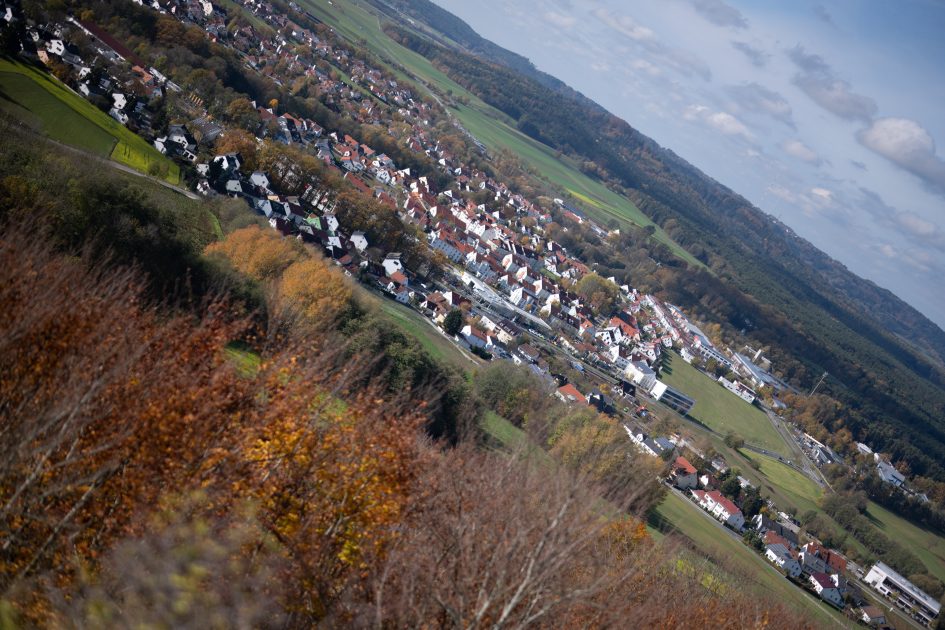
Above: Nikon Z 58mm f0.95 S Noct at f0.95; click image for 4k version

Above: Nikon Z 58mm f0.95 S Noct at f0.95; click image for 4k version, also available as large original at f0.95, f1.2, f1.4, f1.8, f2.0, f2.8, f4.0, f5.6, f8.0, f11

Above: Mitakon 50mm f0.95 III at f0.95; click image for 4k version, also available as large original at f0.95, f1.4, f2.0, f2.8, f4.0, f5.6, f8.0
The Z Noct produces just a slight magenta line at high contrast borders but otherwise shows very good performance already at f0.95. The Mitakon by comparison looks mushy with a strong halo in the center and fuzzy corners.
Let’s see how the Z Noct compares to other lenses at f1.4:

Above: Nikon Z 58mm f0.95 S Noct at f1.4

Above: Zeiss Otus 55mm f1.4 at f1.4; click image for 4k version, also available as large original at f1.4, f1.8, f2.0, f2.8, f4.0, f5.6, f8.0, f11

Above: Nikon 58mm f1.4G at f1.4; click image for 4k version, also available as large original at f1.4, f1.8, f2.0, f2.8, f4.0, f5.6, f8.0, f11

Above: Mitakon 50mm f0.95 III at f1.4
The Zeiss Otus shows again that it produces an excellent FX-corner even better than the Nikon Z 58mm f0.95 S Noct at f1.4. But the Otus seems just a bit less sharp in the center and the DX-corner. Nikon’s 58mm f1.4G produces a strong magenta halo even stronger than the Mitakon at f1.4 but has the benefit of being more evenly sharp across the full-frame sensor than the Mitakon which again shows the softest corners in this comparison.
At f2.0 the Nikon Z 50mm f1.8 S enters the comparison:

Above: Nikon Z 58mm f0.95 S Noct at f2.0

Above: Zeiss Otus 55mm f1.4 at f2.0

Above: Nikon Z 50mm f1.8 S at f2.0; click image for 4k version, also available as large original at f1.8, f2.0, f2.8, f4.0, f5.6, f8.0, f11

Above: Nikon 58mm f1.4G at f2.0

Above: Mitakon 50mm f0.95 III at f2.0
At f2.0 magenta outlining across high contrast borders is mostly gone from the lenses except for the 58mm f1.4G. Nikon’s new Z 58mm f0.95 S Noct is now clearly ahead of the Otus and the other lenses in this comparison. The Mitakon now also delivers an extra sharp center on a par with the Z Noct but has again the softest corners.
Now let’s see how the Z Noct Nikkor develops when stopped further down:

Above: Nikon Z 58mm f0.95 S Noct at f2.8

Above: Nikon Z 58mm f0.95 S Noct at f4.0

Above: Nikon Z 58mm f0.95 S Noct at f5.6

Above: Nikon Z 58mm f0.95 S Noct at f8.0

Above: Nikon Z 58m f0.95 S Noct at f11
The new Nikon Z 58mm f0.95 S Noct repeats its excellent performance in this long-distance test.
Vignetting, transmission, and distortions
With Nikon’s Z cameras you can select the degree of Vignette Control in camera between High, Normal, Low, and Off. Sadly Adobe’s RAW converter ignores all lens profile settings and treats them as if they are set to Normal/On while Nikon’s Capture NX-D software allows to change the settings when developing RAWs.
To make it easier to see light fall-off in the corners of a full-frame sensor I’ve arranged a series of three shots with the Nikon Z 58mm f0.95 S Noct at different apertures. All images were developed to the same brightness in the center and the lens profile applied with Vignette Control in camera set to Normal. This lifts the extreme corners by about 1/2 to 2/3 EV at f0.95:

Above: Nikon Z 58mm f0.95 S Noct at f0.95, f1.4, f2.0
The sample images above show that with the lens profile set to normal vignetting remains slightly visible until f2.0. This looks similar to the Mitakon with of the Adobe lens profile applied:
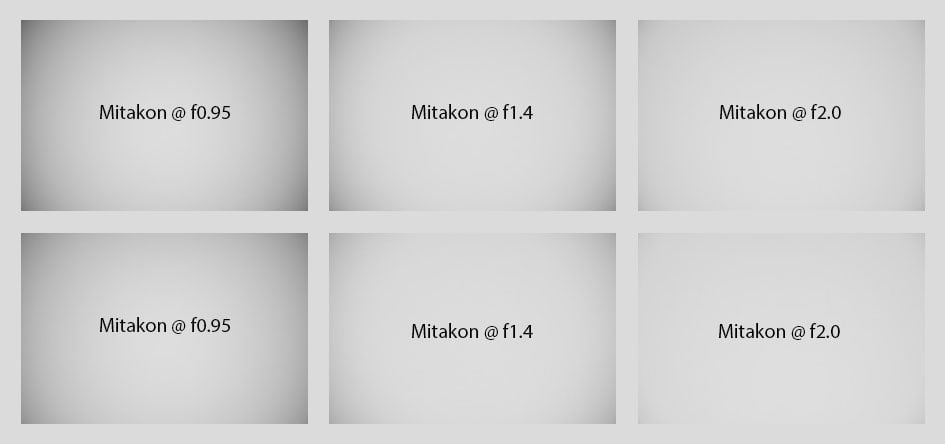
Above: Mitakon 50mm f0.95 III at f0.95, f1.4, f2.0; without lens profile (top), with Adobe lens profile (bottom)
While shooting the Z-Noct and the Mitakon under comparable conditions I observed the Mitakon needing longer exposure times. Which indicates that the transmission of light is a bit lower on the Mitakon than on the Z-Noct. To find out more about any differences in transmission between both lenses I set up some test-shots at f0.95 under controlled conditions with identical lighting. Here is what I got after adjusting white-balance to make both lenses comparable and cropping from the center of the images to avoid light falloff:
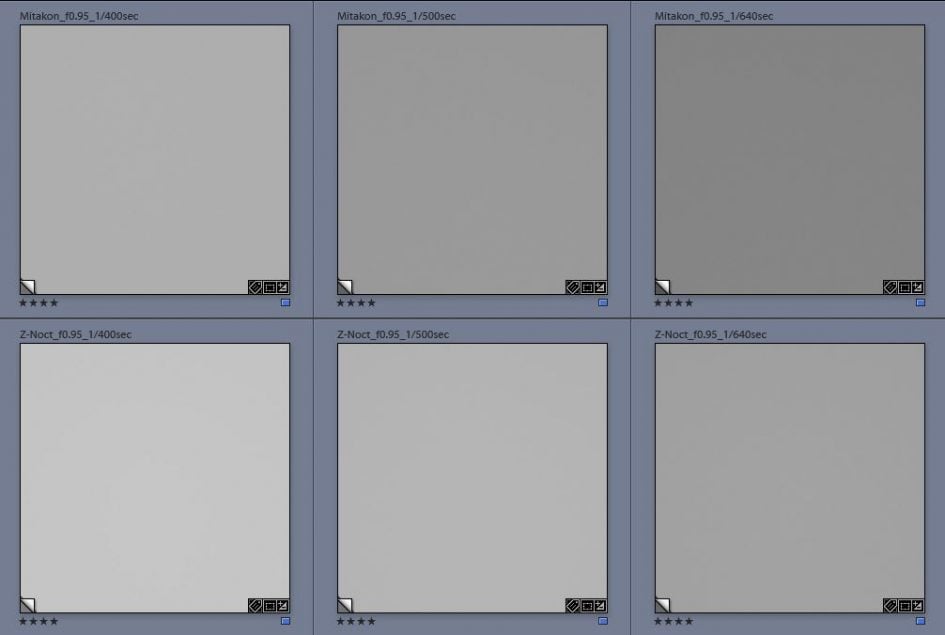
Above: Mitakon 50mm f0.95 III (top) vs. Nikon Z 58mm f0.95 S Noct (bottom) at f0.95, ISO 64, crop from the center
The Mitakon at 1/400 sec is 1/10 EV darker than the Z-Noct at 1/500 sec and 2/10 EV brighter than the Z-Noct at 1/640 sec. This means that the Mitakon transmits -0.43 EV less light than the Z-Noct – or the other way around: The Z-Noct is almost 1/2 Stop brighter than the Mitakon although having the same nominal focal ratio. The reasons probably having to do with better coating and higher quality glas.
Regarding distortions: The Z 58mm f0.95 S Noct is very well-corrected through Nikon’s lens profile as you can see in the examples at the end of the samples page. Although there is no heavy distortion of the lens to begin with.
Rendering of point-light sources at night-shots
Night-shots pose a different challenge for lenses as the contrast is even higher than under bright sun and point-light sources can reveal some weaknesses such as coma, haloing and colour-aberrations that do not show up as prominently in other test-shots. The 100% crops below the main image show the effect of coma in the FX-corner of the new Z Noct Nikkor and the other lenses at various apertures:
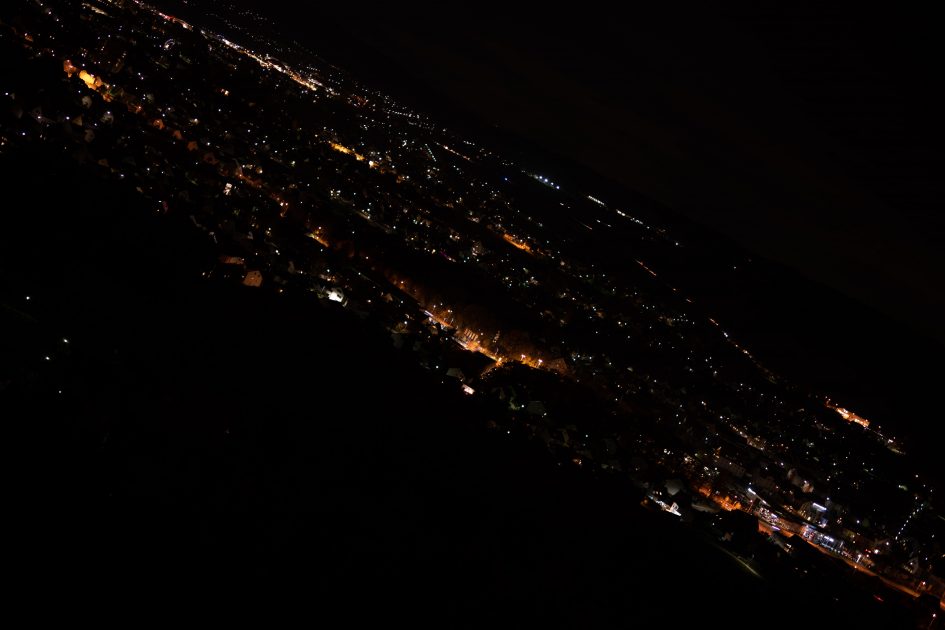
Above: Nikon Z 58mm f0.95 S Noct at f0.95; click image for 4k version, also available as large original at f0.95, f1.2, f1.4, f1.8, f2.0, f2.8, f4.0, f5.6, f8.0

Above: Nikon Z 58mm f0.95 S Noct; 100% crops from the FX-corner at f0.95 (left), f1.4 (middle), f2.0 (right)

Above: Mitakon 50mm f0.95 III; 100% crops from the FX-corner at f0.95 (left), f1.4 (middle), f2.0 (right)

Above: Zeiss Otus 55mm f1.4; 100% crops from the FF-corner at f1.4 (left), f2.0 (middle), f2.8 (right)

Above: Nikon 58mm f1.4G; 100% crops from the FX-corner at f1.4 (left), f2.0 (middle), f2.8 (right)

Above: Nikon Z 50mm f1.8 S; 100% crops from the FF-corner at f1.8 (left), f2.0 (middle), f2.8 (right)
The new Nikon Z 58mm f0.95 S Noct is not free of coma but it is certainly up there with the best like the Zeiss Otus 55mm f1.4 – at f1.4. Good thing is that the coma flare does not get stronger when opening the Noct to f0.95. Bravo! For comparison have a look at the Mitakon 50mm f0.95 III to see a classical example of strong coma.
Rendering of out-of-focus point-light sources
This test is for the rendering of point-light sources in an out-of-focus background. The circle of confusion that is produced by this test is pretty indicative of Bokeh performance (in the background) and light fall-off. Ideally the out-of-focus image of the point-light is evenly lit and perfectly circular, with no “onion-rings”, and without coloration. Large aperture lenses normally produce an effect known as “cat’s eye” the further away from the optical axis the point-light is projected. This is due to optical vignetting in the lens barrel when light enters the lens from an angle.
The new Z Noct Nikkor is first, followed by the alternatives.
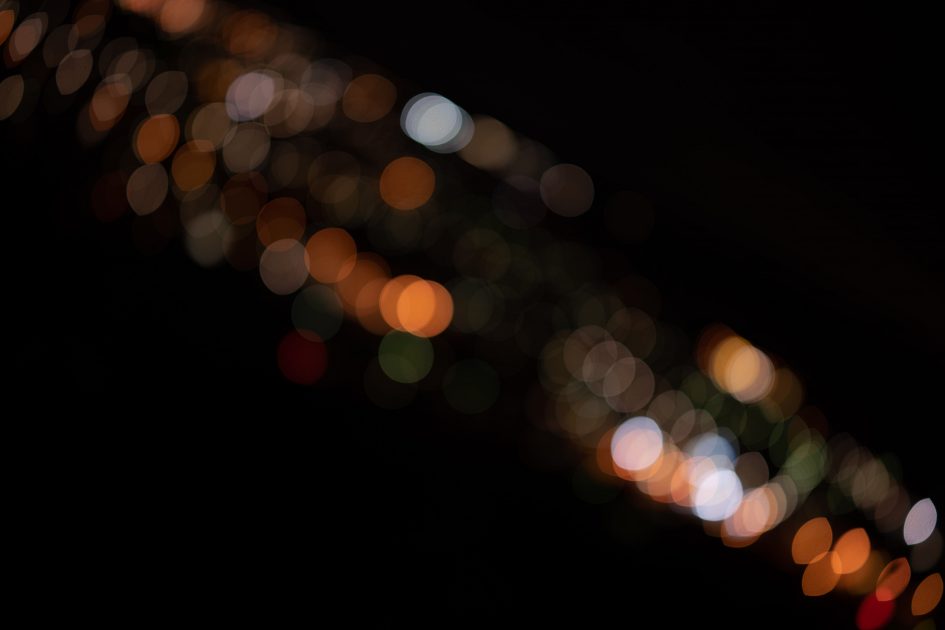
Above: Nikon Z 58mm f0.95 S Noct at f0.95; click image for 4k version

Above: Nikon Z 58mm f0.95 S Noct at f0.95; 44% crops from center, DX-corner, FX-corner; click image for 4k version, also available as large original at f0.95, f1.2, f1.4, f1.8, f2.0, f2.8, f4.0, f5.6, f8.0

Above: Mitakon 50mm f0.95 III at f0.95; 44% crops from center, DX-corner, FX-cornerr; click image for 4k version, also available as large original at f0.95, f1.4, f2.0, f2.8, f4.0, f5.6, f8.0

Above: Zeiss Otus 55mm f1.4 at f1.4; 44% crops from center, DX-corner, FX-corner; click image for 4k version, also available as large original at f1.4, f1.8, f2.0, f2.8, f4.0, f5.6, f8.0

Above: Nikon 58mm f1.4G at f1.4; 44% crops from center, DX-corner, FX-corner; click image for 4k version, also available as large original at f1.4, f1.8, f2.0, f2.8, f4.0, f5.6, f8.0

Above: Nikon Z 50mm f1.8 S at f1.8; 44% crops from center, DX-corner, FX-corner; click image for 4k version, also available as large original at f1.8, f2.0, f2.8, f4.0, f5.6, f8.0
The diameter of the Bokeh balls in the center is determined by the entrance pupil of the lens. So it’s no surprise that at their respective largest aperture the Nikon Z 58mm f0.95 S Noct wins with its 16% longer focal length over the Mitakon 50mm f0.95 III. The Nikon 58mm f1.4G comes third place followed by the 55mm f1.4 Otus with the 50mm f1.8 Z Nikkor coming last. Onion rings or texture within the Bokeh balls are almost a non-issue with only the 58mm f1.4G Nikkor and the Z 50mm f1.8 S Nikkor showing slight rings, the latter also some texture. But I wouldn’t worry about those. Outlining may be more of a distractor but even with the Z 50mm f1.8 S and the Zeiss Otus it is relatively mild. Cat’s eyes towards the corners are most prominent with the Zeiss Otus and the Z Noct.
Now let’s see how this analysis of out-of-focus point-light sources translates into Bokeh-performance shooting a book-shelf.
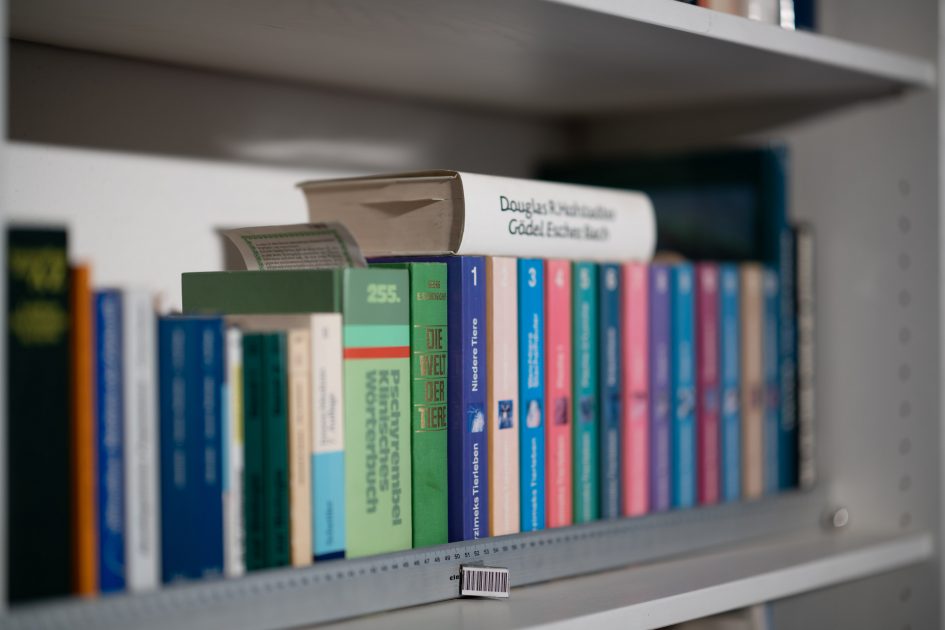
Above: Nikon Z 58mm f0.95 S Noct at f0.95; click image for 4k version

Above: Nikon Z 58mm f0.95 S Noct at f0.95; 44% crops from foreground, middle-ground, background; click image for 4k version, also available as large original at f0.95, f1.2, f1.4, f1.8, f2.0, f2.8, f4.0, f5.6

Above: Mitakon 50mm f0.95 III at f0.95; 44% crops from foreground, middle-ground, background; click image for 4k version, also available as large original at f0.95, f1.4, f2.0, f2.8, f4.0, f5.6

Above: Zeiss Otus 55mm f1.4 at f1.4; 44% crops from foreground, middle-ground, background; click image for 4k version, also available as large original at f1.4, f1.8, f2.0, f2.8, f4.0, f5.6

Above: Nikon 58mm f1.4G at f1.4; 44% crops from foreground, middle-ground, background; click image for 4k version, also available as large original at f1.4, f1.8, f2.0, f2.8, f4.0, f5.6

Above: Nikon Z 50mm f1.8 S at f1.8; 44% crops from foreground, middle-ground, background; click image for 4k version, also available as large original at f1.8, f2.0, f2.8, f4.0, f5.6
The f0.95 lenses take the lead here with the Noct besting the Mitakon with a smoother transition zone in the middle-ground and a much better foreground blur. Both the Z Nikkor and the Zeiss Otus perform pretty comparable wide open although the Otus was shot at f1.4. The Nikon 58mm f1.4G suffers from a nervous background, a pretty ugly foreground plus longitudinal CA creating greenish coloration in the transition zone.
Portrait performance
58mm focal length may not be the classical choice for portraits on a full-frame camera but when you can get a bit closer it is still good for upper body or full body shots. The following shots were all done from the same position/distance so perspective does not change between shots. There is slightly different framing from different effective focal length at the shooting distances and there are also some slight focus-differences which inevitably occur when you shoot a living, breathing subject. All images were developed from RAW to Adobe Color profile with identical white balance.
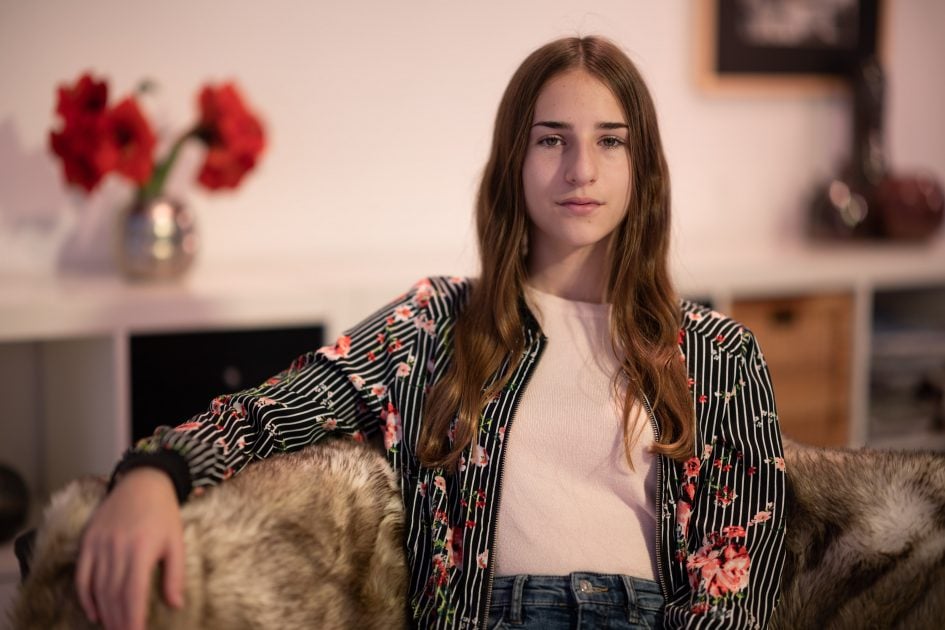
Above: Nikon Z 58mm f0.95 S Noct at f0.95; click image for 4k version

Above: Nikon Z 58mm f0.95 S Noct at f0.95 50% crop; click image to view 100% crop, also available as large original at f0.95, f1.2, f1.4, f1.8, f2.0

Above: Mitakon 50mm f0.95 III at f0.95, 50% crop; click image to view 100% crop, also available as large original at f0.95, f1.4, f2.0, f2.8

Above: Zeiss Otus 55mm f1.4 at f1.4, 50% crop; click image to view 100% crop, also available as large original at f1.4, f1.8, f2.0, f2.8

Above: Nikon 58mm f1.4G at f1.4, 50% crop; click image to view 100% crop, also available as large original at f1.4, f1.8, f2.0, f2.8

Above: Nikon Z 50mm f1.8 S at f1.8, 50% crop; click image to view 100% crop, also available as large original at f1.8, f2.0, f2.8
I think the Z Noct renders the most beautiful image here: Sharp where it should be with a smooth, soft transition and a nicely blurred background. The Mitakon simply does not produce the “pop” as it is too soft at f0.95. Of the other lenses the Nikon 58mm f1.4G also produces a softer focal plane.
Now, many differences in the above samples are results of the different apertures. So the question is: How big are the differences when all lenses are shot at the same aperture. The following crops are all from the respective shots at f2.0:

Above: Nikon Z 58mm f0.95 S Noct at f2.0 50% crop; click image to view 100% crop

Above: Mitakon 50mm f0.95 III at f2.0, 50% crop; click image to view 100% crop

Above: Zeiss Otus 55mm f1.4 at f2.0, 50% crop; click image to view 100% crop

Above: Nikon 58mm f1.4G at f2.0, 50% crop; click image to view 100% crop

Above: Nikon Z 50mm f1.8 S at f2.0, 50% crop; click image to view 100% crop
Obviously all lenses become sharper now but the Mitakon and the Nikon 58mm f1.4G still lag a bit behind the other lenses visible even in 50% crops. That may surprise a bit as the Mitakon produces a very sharp center at f2.0 in my tests with the Siemens stars. But keep in mind that the eye of the girl is about 8mm off-center where sharpness of the Mitakon already starts to deteriorate.
Close-up performance
The Z 58mm f0.95 S Noct goes down to 1:4.9 magnification which is already quite interesting for close-ups. And its performance is surprisingly good even wide open at f0.95. The following image was shot at 1:5.2 magnification where the area of sharp focus is just 125 x 187mm. The crops shown below are from the center, 12mm, and 20mm off the center of the sensor respectively:

Above: Nikon Z 58mm f0.95 S Noct at f0.95, 1:5.2 magnification; 100% crops

Above: Nikon Z 58mm f0.95 S Noct at f2.0, 1:5.2 magnification; 100% crops

Above: Nikon Z 58mm f0.95 S Noct at f4.0, 1:5.2 magnification; 100% crops
This is much better than e.g. the Z 50mm f1.8 S can do.
Flare, glare, ghosting, and sun-stars
Catching a strong light-source shining directly into the lens is always a risky business: it could produce strange colorful ghost-images or reduce contrast considerably through flare and glare. The appearance of flare and ghosting depends on factors like the aperture and the angle of the light hitting the lens. So to judge the proclivity of the new Nikon Z 58mm f0.95 S Noct for these artifacts I went through a series of well calculated shots against a strong light source to provoke glare and ghosting. The lens hood was mounted in all shots. Following is one of the more extreme example results. The little bright square inset in the upper left shows the respective area with an exposure compensation of +3 EV to make it easier to see which levels of black the lens renders at that point:
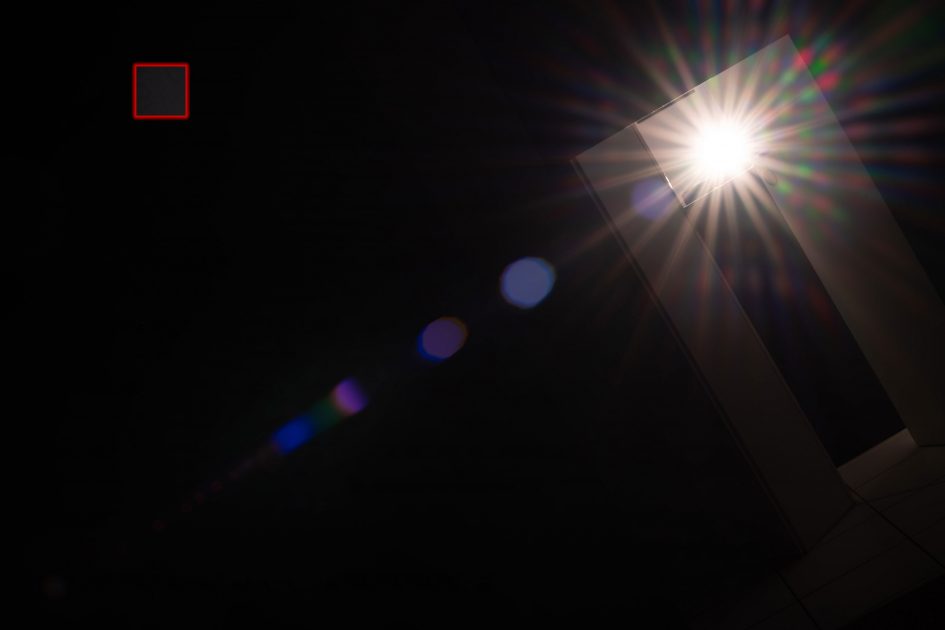
Above: Flare and ghosting. Strong light hitting the Nikon Z 58mm f0.95 S Noct at f11; click image for 4k version or here for +3 EV exposure compensation
Flare and glare is pretty well controlled but the lens shows clear ghosts from the aperture at f11. These ghosts become larger but less bright at larger apertures. For comparison have a look at the Mitakon 50mm f0.95 III, Nikon 58mm f1.4G, Zeiss Otus 55mm f1.4, and the Nikon Z 50mm f1.8 S all shown at f11.
The lens does not produce the typical flare which many lenses show when the light-source is just outside the corner. For comparison have a look at the Mitakon 50mm f0.95 III.
All-in-all the Nikon Z 58mm f0.95 S Noct let’s you shoot pretty confidently under adverse contra-light situations which is quite a feat for a complex lens construction with 20 glass/air surfaces. And although it produces more ghosts I prefer the low level of glare over the Zeiss Otus because it gives an overall cleaner image. The only drawback being that the Z7 might add some colorful “teardrops” to very bright sunstars as can be seen above. The effect can not always be seen though as the examples below show. To produce nice sunstars the new Nikon Z 58mm f0.95 S Noct needs to be stopped down to 5.6:

Above: Sunstars from the Nikon Z 58mm f0.95 S Noct at f5.6 (left) and f8.0 (right), 100% crops
Next check out my sample images!
Check prices on the Nikon Z 58mm f0.95 Noct at B&H, Adorama, or Wex. Alternatively get yourself a copy of my In Camera book or treat me to a coffee! Thanks!



